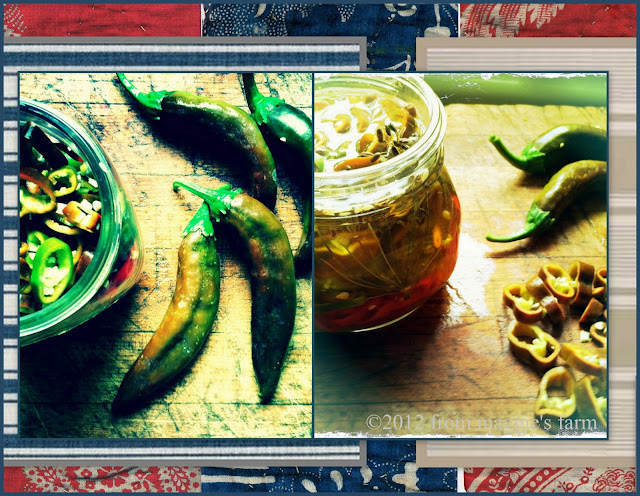notes from maggie's farm
This week on Notes From Maggie's Farm, we're Putting Food By. Yesterday, we tackled preserving by way of refrigerated pickling, and now we're ready to move onto shelf-stable canning. There are two methods for safe canning-- boiling water-bath canning, and pressure canning. Today we'll explore the first of those; the who (YOU!), why, what, and how of water-bath canning, and tips from the experts.
You CAN do this!
How Canning Preserves Foods
The high percentage of water in most fresh foods makes them very perishable. They spoil or lose their quality for several reasons:
growth of undesirable microorganisms-bacteria, molds, and yeasts,
activity of food enzymes,
reactions with oxygen,
moisture loss.
Microorganisms live and multiply quickly on the surfaces of fresh food and on the inside of bruised, insect-damaged, and diseased food. Oxygen and enzymes are present throughout fresh food tissues.
Proper canning practices include:
carefully selecting and washing fresh food,
peeling some fresh foods,
hot packing many foods,
adding acids (lemon juice or vinegar) to some foods,
using acceptable jars and self-sealing lids,
processing jars in a boiling-water or pressure canner for the correct period of time.
Collectively, these practices remove oxygen; destroy enzymes; prevent the growth of undesirable bacteria, yeasts, and molds; and help form a high vacuum in jars. Good vacuums form tight seals which keep liquid in and air and microorganisms out.
extracted from the "Complete Guide to Home Canning," Agriculture Information Bulletin No. 539, USDA (Revised 2009).
Steps for Water-Bath Canning
Follow these steps for successful boiling water canning:
(Read through all the instructions before beginning.)
1. Before you start preparing your food, place canner rack in the bottom of a boiling water canner. Fill the canner half full with clean warm water for a canner load of pint jars. For other sizes and numbers of jars, you will need to adjust the amount of water so it will be 1 to 2 inches over the top of the filled jars.
2. Center the canner over the burner and preheat the water to 140 degrees F. for raw-packed foods and to 180 degrees F. for hot-packed foods. You can begin preparing food for your jars while this water is preheating.
3. Load filled jars, fitted with lids and ring bands, into the canner one at a time, using a jar lifter. When moving jars with a jar lifter, make sure the jar lifter is securely positioned below the neck of the jar (below the ring band of the lid). Keep the jar upright at all times. Tilting the jar could cause food to spill into the sealing area of the lid.
If you have a shaped wire rack that has handles to hold it on the canner sides, above the water in the canner, you can load jars onto the rack in the raised position and then use the handles to lower the rack with jars into the water.
4. Add more boiling water, if needed, so the water level is at least one inch above the jar tops. Pour the water around the jars and not directly onto them. For process times over 30 minutes, the water level should be 2 inches above the jars.
5. Turn the heat setting to its highest position, cover the canner with its lid and heat until the water boils vigorously.
6. Set a timer (after the water is boiling) for the total minutes required for processing the food.
7. Keep the canner covered for the process time. The heat setting may be lowered as long as a gentle but complete boil is maintained for the entire process time.
8. Add more boiling water during the process, if needed, to keep the water level above the jar tops. Pour the water around the jars and not directly onto them.
9. If the water stops boiling at any time during the process, turn the heat on its highest setting, bring the water back to a vigorous boil, and begin the timing of the process over, from the beginning (using the total original process time).
10. When the jars have been processed in boiling water for the recommended time, turn off the heat and remove the canner lid. Wait 5 minutes before removing jars to allow the canner contents to settle. This waiting period is not required for safety of the food when using USDA or University of Georgia processing times, however.
11. Using a jar lifter, remove the jars one at a time, being careful not to tilt the jars. Carefully place them directly onto a towel or cake cooling rack, leaving at least one inch of space between the jars during cooling. Avoid placing the jars on a cold surface or in a cold draft.
12. Let the jars sit undisturbed while they cool, from 12 to 24 hours. Do not tighten ring bands on the lids or push down on the center of the flat metal lid until the jar is completely cooled.
13. Remove ring bands from sealed jars. Put any unsealed jars in the refrigerator and use first.
14. Wash jars and lids to remove all residues.
15. Label jars and store in a cool, dry place out of direct light.
from the University of Georgia. Andress, E. (2011rev.). Preserving Food: Using Boiling Water Canners. Athens, GA: University of Georgia, Cooperative Extension.
Learn More:
National Center for Home Food Preservation






I remember my mom canning stuff from her garden when I was growing up. I love how you went through the process step by step!
ReplyDeleteMy mom died in 1993, and I wouldn't know where to begin. Thank goodness for you and your website!!
Kathy
http://gigglingtruckerswife.blogspot.com
Hi, Kathy!
DeleteWell, bless your heart! Such kind words! If you have any questions at all, please don't hesitate to give me a shout. I'd be thrilled to help you can. Because you CAN! lol